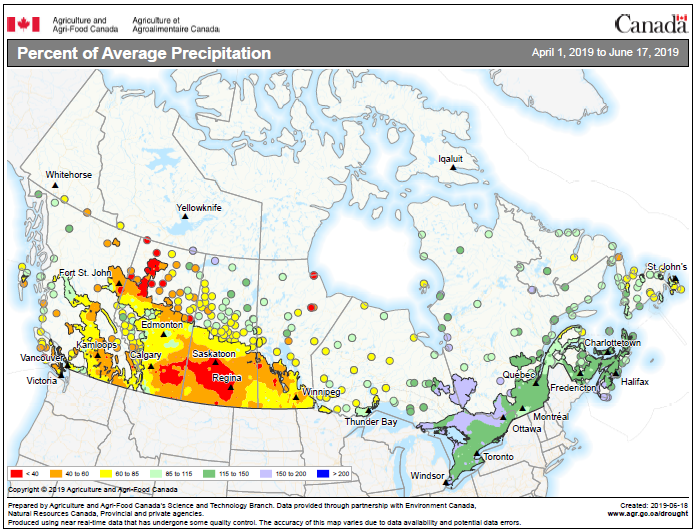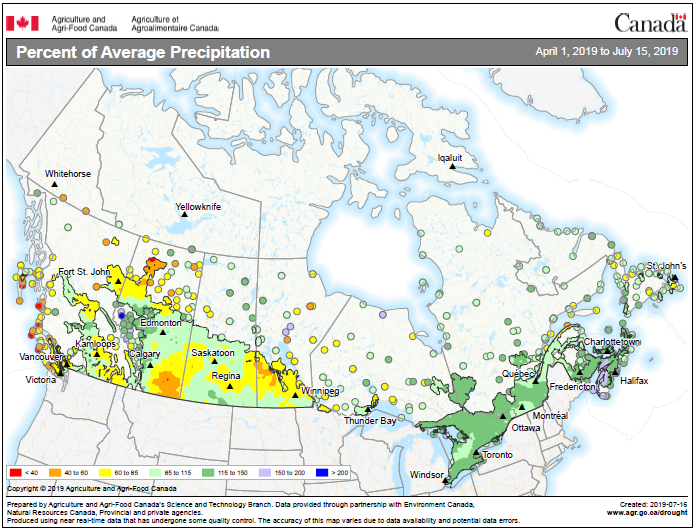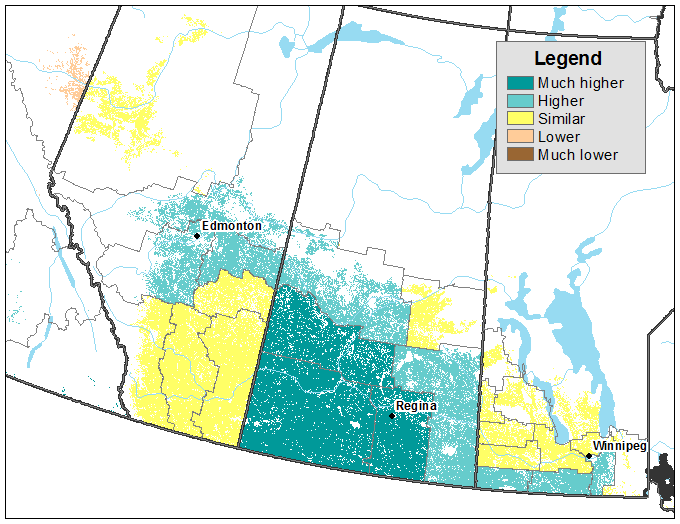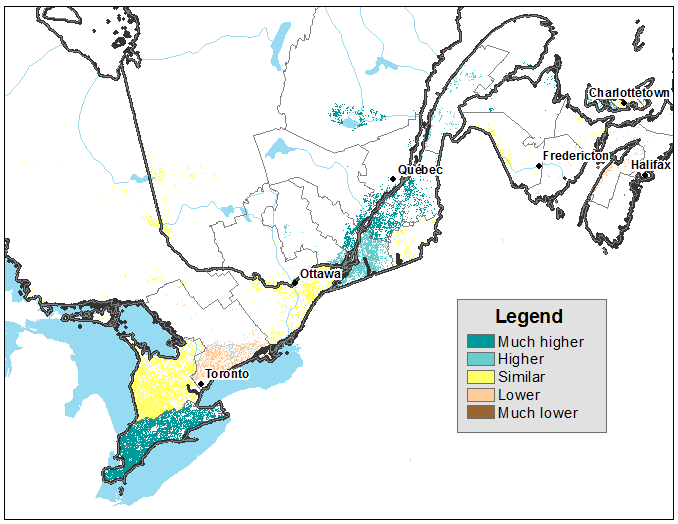Production of principal field crops, July 2019
Archived Content
Information identified as archived is provided for reference, research or recordkeeping purposes. It is not subject to the Government of Canada Web Standards and has not been altered or updated since it was archived. Please "contact us" to request a format other than those available.
Released: 2019-08-28
Farmers across Canada anticipate producing less wheat, canola, corn for grain and soybeans in 2019 from a year earlier, but more barley and oats, according to results from the July field crop survey.
Despite dry conditions across the Prairies early in the growing season, timely rain beginning in late June and early July helped to increase crop health in several parts of Western Canada, notably throughout parts of Saskatchewan and southern Manitoba.
A comparison of precipitation from earlier in the growing season to mid-July, during collection of the July field crop survey, shows that moisture conditions have improved noticeably.
Results of the Crop Condition Assessment Program show that overall plant growth improved in many parts of Western Canada throughout July as survey collection progressed. Cool and wet spring weather in Eastern Canada resulted in poor planting conditions and contributed to slow crop development early in the season. During the collection period, the situation improved in southern Ontario and eastern Quebec.
Wheat production is expected to decline due to lower harvested area and yields
Nationally, wheat production is anticipated to fall 2.9% from a year earlier to 31.3 million tonnes in 2019, driven by a 1.1% decline in harvested area. Yields are expected to decline 2.1% to 47.5 bushels per acre.
The anticipated decrease in wheat production is largely attributable to lower winter wheat and durum wheat production, due to fewer planted and harvested acres in 2019. Conversely, spring wheat area and production are both expected to increase.
In Saskatchewan, producers expect wheat production to decline 3.9% year over year to 14.1 million tonnes, driven by lower anticipated yields, down 3.3% to 40.9 bushels per acre. Farmers expect the harvested area to edge down 0.6% to 12.7 million acres.
Wheat farmers in Alberta anticipate that yields will increase 2.4% to 50.9 bushels per acre in 2019. Despite a 1.8% drop in harvested area, total wheat production is expected to rise 0.5% to 10.1 million tonnes.
Wheat production in Manitoba is estimated to rise 5.5% to 5.1 million tonnes in 2019, the result of a larger harvested area, up 7.8% to 3.1 million acres. Yields are estimated to be stable at 59.6 bushels per acre.
Ontario farmers expect wheat production (most of which is winter wheat) to fall by 29.4% to 1.6 million tonnes. This is the result of lower harvested acres (-24.8%) and yields (-6.2%). The anticipated decrease in harvested area is attributable to harsh winter and spring weather conditions.
Canola production is expected to increase in Manitoba and decline in Saskatchewan and Alberta
Nationally, farmers anticipate producing 18.5 million tonnes of canola in 2019, down 9.3% from 2018, driven largely by an 8.3% decrease in harvested area to 20.7 million acres. Lower harvested areas may be attributable to a decline in seeded area following the ongoing trade issues surrounding the limited access to Chinese export markets. Despite a dry start to the year, increased moisture beginning in late June helped crop development, resulting in farmers reporting an expected average yield of 39.4 bushels per acre, down 1.0% from the previous year.
In Saskatchewan, farmers expect to produce less canola compared with the previous year, down 12.4% to 9.6 million tonnes. This decrease is attributable to a 7.1% decline in harvested area from the previous year. Yields are anticipated to decrease 5.6% to 37.1 bushels per acre.
Farmers in Alberta expect canola yields to increase 3.4% to 40.1 bushels per acre in 2019. Despite higher anticipated yields, a 12.6% decrease in harvested area contributed to an anticipated 9.4% decrease in production to 5.3 million tonnes.
Yields in Manitoba are estimated at 45.8 bushels per acre in 2019. Despite an anticipated decline of 2.5% in harvested area, production is expected to increase to 3.4 million tonnes (+3.1%).
Lower corn for grain production expected in Central Canada
Nationally, farmers expect to produce less corn for grain compared with the previous year, down 2.0% to 13.6 million tonnes in 2019. Despite increased harvested area, up 2.3% to 3.6 million acres, yields are expected to decrease 4.1% to 148.2 bushels per acre. Both area and yields were likely affected by highly variable weather throughout the year. Poor planting conditions throughout Eastern Canada due to cold and wet conditions caused some farmers to delay planting. Ontario and Quebec received considerable heat combined with little rain throughout July, and this may have further affected the corn for grain crop.
Farmers in Ontario, the largest corn for grain producing province, expect yields to fall 6.0% from the previous year to 156.1 bushels per acre in 2019. Harvested area is expected to increase 4.6% compared with the previous year. As a result, overall production in Ontario is anticipated to fall 1.6% to 8.6 million tonnes.
In Quebec, corn for grain farmers are expecting production to fall 8.6% to 3.3 million tonnes in 2019, due to lower anticipated harvested area (-2.0%, to 928,700 acres). Yields are expected to decrease 6.8% to 140.2 bushels per acre.
Soybean production is expected to fall
Nationally, farmers anticipate that soybean yields will fall 5.4% to 40.2 bushels per acre in 2019. Harvested area is expected to decline 9.7% to 5.7 million acres, resulting in a 14.6% production decline to 6.2 million tonnes.
Like corn for grain, poor spring planting conditions in Eastern Canada, coupled with increasingly hot and dry conditions throughout July, likely contributed to lower yields in Quebec and Ontario. Combined, these two provinces account for the majority of soybeans produced in Canada.
Soybean farmers in Ontario expect production to decrease 12.5% to 3.7 million tonnes in 2019. Harvested area is expected to rise 3.0% to 3.1 million acres, while yield is anticipated to decline 15.2% to 43.6 bushels per acre.
In Manitoba, soybean production is estimated to decline 18.7% to 1.3 million tonnes in 2019, mainly as a result of a 22.3% decrease in harvested area. Yields are estimated at 32.5 bushels per acre in 2019. Lower harvested areas are attributable to farmers in the province choosing to reduce seeded area after several years of lower yields due to dry conditions.
In Quebec, farmers expect soybean yields to decline 8.1% to 43.1 bushels per acre in 2019. Harvested area is expected to decrease 1.4% to 900,100 acres. As a result, production is anticipated to fall 9.3% to 1.1 million tonnes in 2019.
Farmers anticipate harvesting more barley and oats
Nationally, farmers expect to produce 15.1% more barley than a year earlier, with production totalling 9.6 million tonnes in 2019. The increase is driven by higher harvested area (+12.8%, to 6.7 million acres). Yields are expected to increase 2.2% to 66.4 bushels per acre. Both Saskatchewan and Alberta, the two largest barley producing provinces, reported an increase in harvested area and production.
Oat production is anticipated to increase 15.0% to 4.0 million tonnes, a result of greater harvested area (+15.2%, to 2.9 million acres). Yields are expected to be stable at 89.6 bushels per acre.
Note to readers
This release provides the preliminary production estimates for 2019, as well as revised production data for 2018 if applicable. The estimates are derived from the July Farm Survey of crop production covering about 13,110 Canadian farms. The survey was conducted from July 4 to August 5, 2019. Farmers were asked to report their estimated area, yield and production of grains, oilseeds and special crops.
Farm surveys collect data from Quebec, Ontario, Manitoba, Saskatchewan and Alberta for all five survey cycles during the crop year (from March to December). However, data are collected twice a year (in the June Farm Survey on seeded areas and in the November Farm Survey on final crop production) for Newfoundland and Labrador, Prince Edward Island, Nova Scotia, New Brunswick and British Columbia, which together represent from 2% to 4% of national totals.
As of July 2014 for these provinces, July production estimates are calculated using the final estimates of the last three crop years. The harvested area is first estimated based on the ratio obtained from the sum of harvested areas of the last three years over the sum of the seeded areas of the last three years. This average ratio is applied to their current year's seeded acreage from the June survey. This harvested area is then multiplied by the average yield of the last three years to estimate production.
Final production estimates for 2019 will be released on December 6, 2019, and are subject to revision for two years.
On September 12, 2019, Statistics Canada will release modelled yield and production estimates for field crops in Canada. These data are derived from remote sensing, survey and agroclimatic data sources.
Starting in July 2019, July model-based data for Manitoba were used to estimate yield and production. For more information regarding the July model-based data, please visit An Integrated Crop Yield Model Using Remote Sensing, Agroclimatic Data and Crop Insurance Data.
Additional data sources
Readers are invited to visit the Crop Condition Assessment Program web application, which is an additional tool to assess growing conditions of field crops during the crop year. Readers can monitor a vegetation index of crop land on a weekly basis.
Crop Reporting Survey at a Glance: An easy-to-print chart, which provides an overview of the survey cycle, is now available.
Contact information
For more information, or to enquire about the concepts, methods or data quality of this release, contact us (toll-free 1-800-263-1136; 514-283-8300; STATCAN.infostats-infostats.STATCAN@canada.ca) or Media Relations (613-951-4636; STATCAN.mediahotline-ligneinfomedias.STATCAN@canada.ca).
- Date modified:






